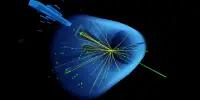A flash of excitement is coming from CERN. In one of the four experiments on the Large Hadron Collider (LHC), the LHCB observed something that violates the accepted theory: the ideal model of particle physics.
The results announced at the Moriond conference and they indicated a violation of the Lepton flavor universality. So what is lepton flavor universality? Leptons are a type of particle that includes particles such as electrons, neutrinos, and electrons, but these heavier particles, known as muon and tau, defined as different “flavors” of leptons. Finally, we get universality.
Electrons, moons and tau particles can communicate through electromagnetic magnetic energy and weak nuclear energy, which is responsible for radioactive decay. Taken together it emphasizes electronic power and the standard model says that this lepton must have the same electrical communication power as one. However, the latest observations now say it may not be. Among the work still available as a finished-review paper, the LHCB collaboration highlights how these results are consistent with recent work from labs around the world, providing a certificate that we are moving closer to finding the limitations of the standard model of particle physics. While these results are exciting, caution is need.
This has not yet confirmed. Although research has shown that the breach is with a confidence level of 99.81 percent or 3.1 sigmas, which is higher, it is far below the gold standard (five sigmas) 99.99994 percent confidence level for discovery to give you an example below, the current result is likely to be wrong in the poker game. More than the possibility of four-one-kind behavior, Five Sigma levels are smaller than the risk of killed by lightning in Germany any year.
LHCb spokesperson Professor Chris Parkes from the University of Manchester and CERN, said in a statement, “If lepton flavor universality is violated, it will require the existence of new physiological processes such as new elementary particles or interactions.” “Further studies on related processes are underway using existing LHCB data. We will be excited to see if they reinforce the bizarre hints in the current results. The LHCB looked at the decay of beauty (or bottom) towards quark, which is one of the six flavors of quark. The measurement looked at how these quarks transformed into different flavors of quarks (amazing quarks). This is a very rare decay and it can occur by producing electrons or by producing moons.
The standard model predicts that both occur with almost the same probability. What they saw in this test is now. The standard model of particle physics is one of the best scientific theories created by humanity but it known as finite and incomplete. It is so exciting to be present at a stage where we can find out what is out there.
















